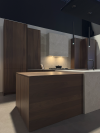
Contemporary kitchens have been growing in popularity across North America in recent years. This sleek style, influenced by European design, appeals with its simplicity, clean lines, and ability to create spaces that are both functional and inviting. Discover its essence and what sets it apart!
Understanding Contemporary Style
Contemporary style, often mistaken for modern style, primarily refers to a current and ever-evolving approach to design. It is defined by a clean aesthetic, natural materials, soft nature-inspired colors, and a strong focus on functionality. It is not tied to any specific era: rather, it is a living trend that adapts to changing needs, technologies, and personal preferences.

Modern or Contemporary?
The difference between the terms "modern" and "contemporary" is sometimes unclear, and the two are often confused. While both are used in the context of clean design characterized by straight lines and the absence of ornamentation, they are in fact quite distinct. "Modern" refers to a design movement that peaked between 1920 and 1960. "Contemporary," on the other hand, simply refers to current trends. Although it draws significant inspiration from the historical modern movement, contemporary design reflects today’s aesthetics and needs.


The contemporary kitchen, usually open onto the other rooms of the house, is often equipped with a big central island. It thus creates a welcoming place for pleasant hosting.
- With its cabinets featuring rectilinear fronts and sometimes even no handles, it gives off a certain tranquility. The addition of a few curves as accents can add a light-hearted touch. Neutral tones, natural wood species, as well as noble materials, namely for countertops, give it an elegance that never goes out of style.
- With its big units, as well as a balanced alternation between open and closed storage spaces, the contemporary kitchen discreetly conceals all the elements stored inside them. Moreover, a preference for integrated appliances is a clever and refined way of paring down the room even more and adding a touch of elegance.
The contemporary style is probably one of the most malleable and easy to adapt over the years and according to current trends. And actually, that’s how a great number of other styles were born. Think of the Scandinavian style, a Nordic adaptation of the contemporary, or even the transitional style, a modern version softened by a touch of more classic ornamentation. Basically, the contemporary style adapts to any environment. It can even integrate into a completely opposite kind of space, such as an ancestral home, and create a dazzling eclectic decor.
Scandinavian style

Transitional style

Contemporary kitchens are also perfectly suited to accommodate the latest technological innovations. Although minimalist in nature, functionality lies at the heart of their design.
For some, contemporary kitchens may feel cold or impersonal due to their streamlined appearance. That’s why the choice of materials, colors, and accessories plays a key role in creating a warm and inviting atmosphere. A thoughtful, well-planned design helps avoid these pitfalls by emphasizing ergonomics, visual balance, and the unique character of the space.
At Miralis, materials such as our advanced-engineering wood, our wide range of laminate colors, and our advanced-engineering FENIX, known for their soft touch and durability, add depth and richness to the kitchen. Our nature-inspired finishes and carefully curated color palettes help bring warmth to contemporary design without compromising its clean lines.
Ultimately, the essence of contemporary style lies in the balance between form and function, free from unnecessary details or ornamentation. Constantly evolving, it continues to reinvent itself, offering kitchens that are as elegant as they are practical, designed to stand the test of time.